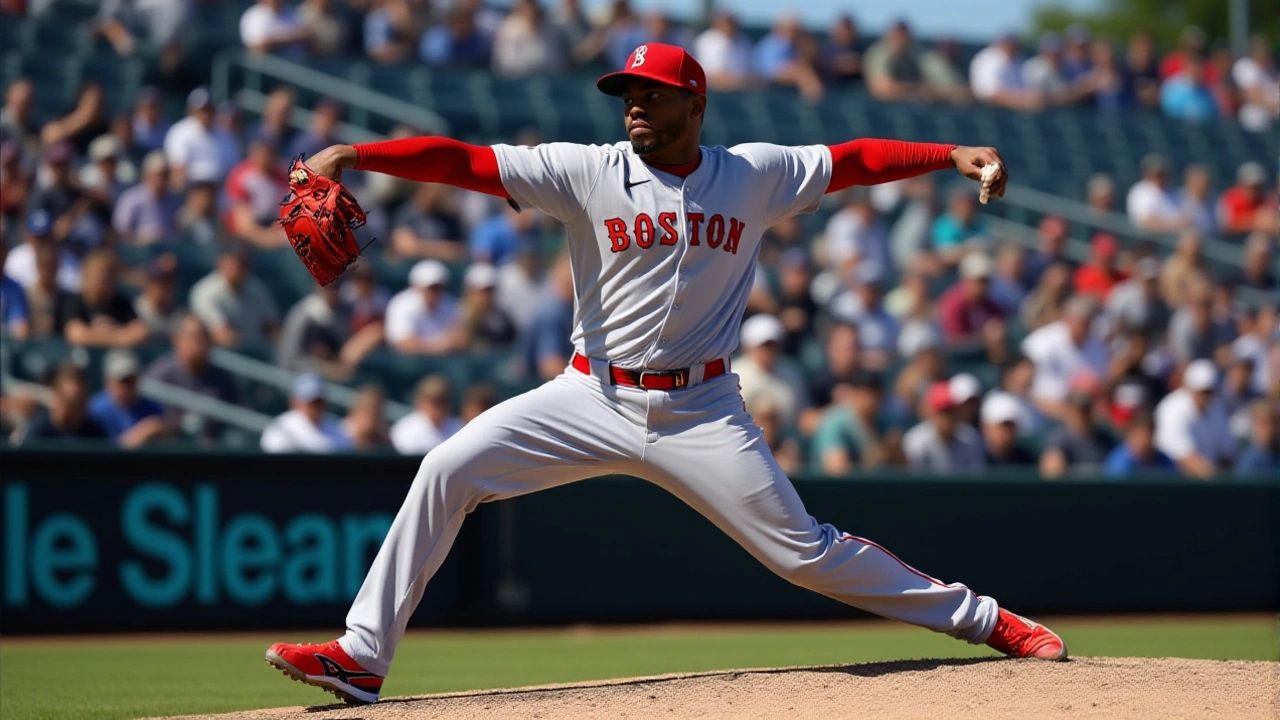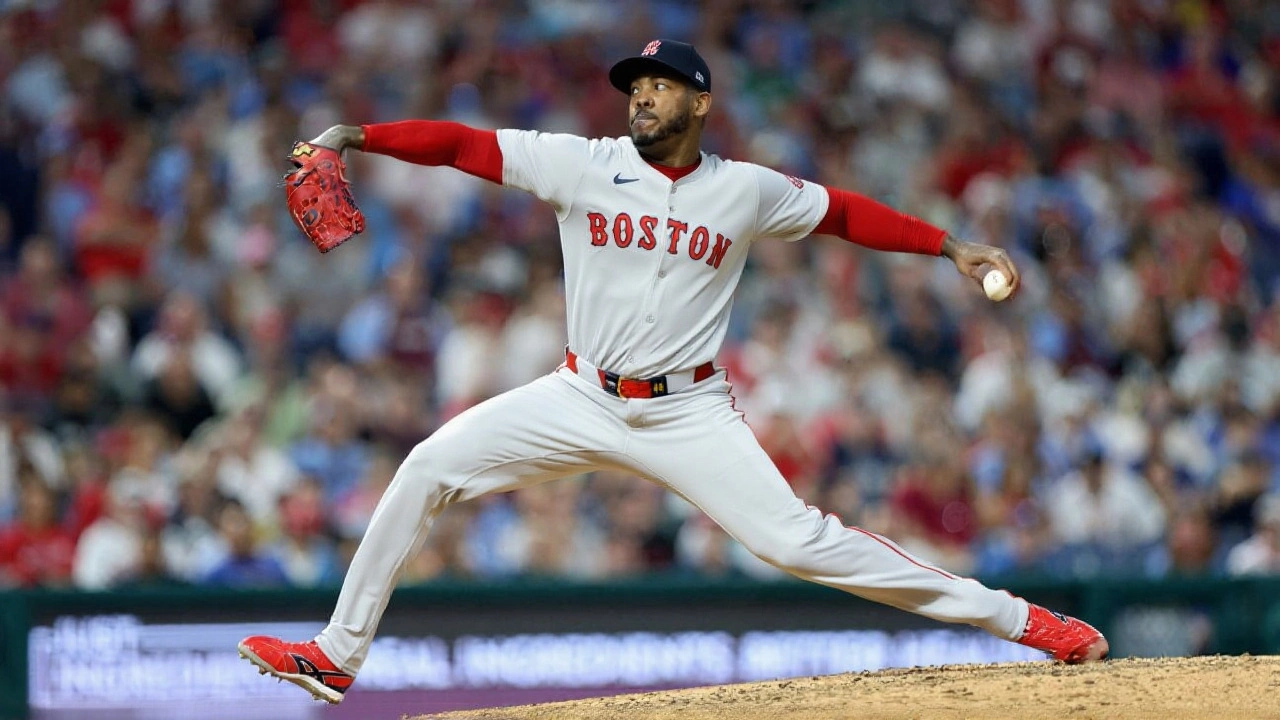When Aroldis Chapman, the closer for the Boston Red Sox, felt a back spasm at Fenway Park during Sunday’s 4‑3 win over the Los Angeles Dodgers, he told a team translator that he expects to be back in a couple of days. The incident unfolded on Red Sox vs Dodgers matchupFenway Park, a game that put Boston one win ahead in the series and kept the AL East race tight.
Background on Chapman and the Red Sox Bullpen
Chapman, a 37‑year‑old Cuban import, has reinvented himself after years of high‑velocity fireballing. This season he’s logged a sub‑1.30 ERA, 32 saves and 85 strikeouts in just over 41 innings, walking a mere 11 batters. His transformation from a wild arm to a control‑oriented closer has been a cornerstone of Boston’s late‑season surge. The Red Sox, who finished last year in the bottom half of the division, have leaned heavily on Chapman’s reliability to keep games within reach.
Meanwhile, the bullpen’s depth has been tested by injuries all year. Reliever Jordan Hicks has pitched 42 innings this season and logged a 2.97 ERA, making him a viable backup when Chapman rests. The presence of veteran arms like Matt Barnes and younger guns such as Nick Pivetta also cushions the impact of any short‑term absence.
The Game‑Day Incident
Chapman entered the eighth inning with Boston clinging to a one‑run lead. He quickly ran into trouble, walking Miguel Rojas on five pitches — the fourth pitch even violated the new MLB pitch‑clock rule. He then walked Mookie Betts on another five‑pitch walk. His fastball, normally capping out at 99‑100 mph, averaged just 94.6 mph, a drop of almost four miles per hour.
After fanning Shohei Ohtani on a fly‑out to the left‑field warning track, Chapman winced while moving toward the third‑base line. A visible limp and a grimace prompted Alex Cora, Boston’s manager, and the team trainer to rush to the mound.
“It’s just a spasm. It should be gone in a couple of days,” Chapman said through a translator, emphasizing his determination to stay in the game. Cora, however, decided to pull the closer, noting the injury as “tight back” and classifying him as a day‑to‑day case.
Team and Manager Reactions
Cora explained that safety trumps heroics: “Alex thought it would be better, smarter that we just ‘call it’ to avoid anything down the line.” The decision sparked a brief debate among the bench, as Chapman reportedly pleaded to stay and face Teoscar Hernández. The morale boost came from relief pitcher Jordan Hicks, who entered with one out and two runners on. Hicks induced a line‑out from Hernández, followed by an unassisted double play by Ceddanne Rafaela at second base, sealing the Yankees‑style escape.
After the game, Chapman admitted he felt a slight spasm on Saturday and “a little uncomfortable” on Sunday before taking the mound. The Red Sox’s medical staff confirmed the issue was isolated to his back, putting to rest earlier worries of an arm injury.

Season‑Long Performance and What It Means
The brevity of the injury matters because Boston sits perched at 88‑71, within five games of the division lead. Losing Chapman, even for a few days, forces the bullpen to stretch. Hicks, who notched his second save of the season, may see a temporary promotion to the ninth‑inning role, but his 2.97 ERA suggests that a sustained workload could raise his fatigue risk.
Statistically, Chapman’s 1.17 ERA and 32 saves rank him among the top three closers in the majors. His walk‑rate of 2.4 per nine innings is a career low, evidencing his refined command. The back spasm, if truly minor, could serve as a reminder that even elite athletes can suffer sudden setbacks, especially amid the compressed schedule that follows the trade‑deadline frenzy.
What’s Next for the Red Sox Relievers
Both Chapman and Cora have projected a return within two days, meaning the Red Sox could field their regular closer for the next series against the New York Yankees. However, the front office remains vigilant. General manager Chaim Bloom has reportedly explored a minor trade to bolster left‑handed depth, just in case the back issue lingers.
If Chapman’s recovery proceeds as expected, the bullpen will likely maintain its current rotation. Yet the episode underscores the importance of contingency planning, especially as Boston eyes the postseason and every saved run counts.
Frequently Asked Questions
How serious is Aroldis Chapman’s back spasm?
Team physicians describe it as a mild spasm with no structural damage. Chapman and manager Alex Cora expect it to resolve in a couple of days, so a short‑term rest is all that’s planned.
Will the Red Sox need to call up a replacement from Triple‑A?
So far, Boston intends to rely on Jordan Hicks, who already earned his second save. A call‑up remains a backup option if Chapman’s recovery stalls.
How does this injury affect Boston’s trade‑deadline strategy?
The front office is monitoring bullpen depth closely. While Chapman’s absence is expected to be brief, the Red Sox may explore adding a left‑handed reliever to hedge against any lingering back issues.
What does Chapman’s recent performance mean for his legacy?
With a sub‑1.20 ERA and over 30 saves, Chapman is on pace to join the elite group of closers with 400 career saves. The current season could cement his place among the all‑time greats, regardless of a brief setback.
When can fans expect to see Chapman back on the mound?
Both the player and the coaching staff are optimistic about a return by the next game, likely the series opener against the Yankees later this week.
